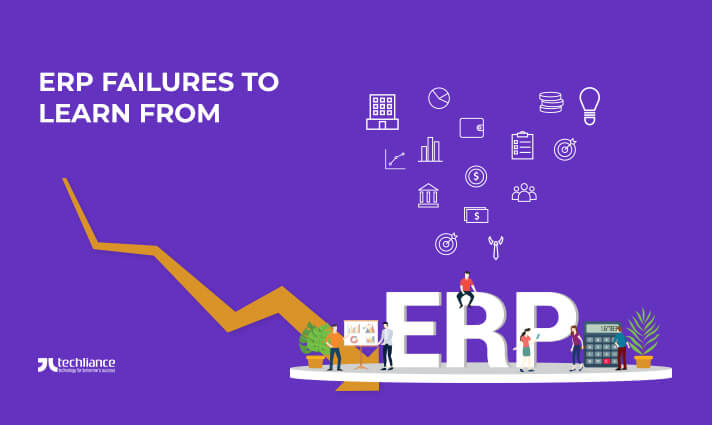Enterprise Resource Planning (ERP) systems make every aspect of a business run smoothly. They offer visibility throughout the business, automate repetitive processes, and are a source of business data crucial for innovation. In short, every type of business needs a reliable ERP system to scale and grow. But the ERP failures, implementation problems included, are common as it is a gigantic endeavor that entails close collaboration with all stakeholders.
What’s rare is when these failures turn into disasters and spiral into a series of lawsuits and litigations with millions of dollars at stake. But when it does come to that, it can turn ugly and what will be left in the scraps are lessons businesses like yours can learn from. Analyzing the cases of previous ERP disappointments can help companies planning to implement ERP systems.
Huge impact ERP Failures that Teach very Valuable Lessons
Here are 5 massive ERP implementation disasters and what you can take away from them.
- Nike
- University of Massachusetts
- Worth & Co
- Lidl
- Revlon

Let’s examine the reason behind these five major ERP failures and the losses they incurred.
Nike
In 2000, Nike lost $100 million in sales after a failure in implementing its i2 ERP software. The loss in sales and the subsequent 20% dip of its stock value, as well as class action lawsuits, were because its system failed to deliver its new Air Jordans and Air Garnett to appropriate distributors. It turns out this was because a $400 million software upgrade in the i2 software contained a glitch. This goes to show how systems must be thoroughly tested before being implemented.
University of Massachusetts
A buggy ERP implementation at the University of Massachusetts in 2004 led to nearly 27,000 students unable to register for classes or collect financial aid checks. The university runs a Spire system that crashed when a hasty implementation of PeopleSoft Web Portal was introduced. A faulty ERP system will cost you more than just delays, as it will damage the reputation of your company, resulting in distrust; that will affect how future clients see you as a reliable option.
ERP implementations in an almost decentralized system, like those in universities, are really challenging. However, with today’s increasingly changing and evolving enterprise software development trends, it is easier to find adequate ERP solutions like adding middle layers or incorporating web-based applications.
Worth & Co
Pennsylvania-based manufacturing firm Worth & Co. filed a lawsuit against Oracle last February over a botched 2015 ERP implementation. The business software provider led the plaintiff on by charging them over $4.5 million for software integration, testing, and training which The Register reports never amounted to a working system. Two commissioned firms – EDREi and Monument Data Solutions – tried to implement Oracle suite in their system but failed and deadlines were pushed back for years.
Oracle and its subsidiary NetSuite enjoys a huge part of the ERP market share as they focus on broader functionality including finance, inventory management, CRM, HCM, and light manufacturing. This is why specialists who can use the program are in such demand, something that is reflected by the increasing number of people learning about it. Udemy’s list of online Oracle database courses shows how over 131,000 students are studying the various applications of the program.
This is because it is an adaptable way of handling, not just large applications, but also massive amounts of structured data. In this case, Worth & Co. asserts that the on-premise and cloud platform itself was problematic. The increasing demand for those with expertise in ERP shows how companies need to make sure they are able to hire the right people to prevent failures, like those on this list, from happening.
Lidl
German discount grocery brand Lidl canceled its SAP introduction last year after spending nearly €500 million ($540 million) to replace its old system. This was after prices in their stores spiraled when consultants implemented a new company-wide system for inventory control.
According to insiders, Lidl declined to change its pricing system from purchase price to retail price, which was the standard for the SAP Retail software. The heavy customization of the code during the change led to an increased risk of failure and, in this case, millions of euros lost.
Revlon
Four law firms are filing class-action lawsuits against cosmetics giant Revlon after it failed to fulfill $64 million in orders due to the SAP implementation disaster. This all started when one of its plants in North Carolina, rolling out its first SAP go-live, experienced shipping delays and lost sales due to production stoppages. The extent of the failure, including the dipping stocks of Revlon; show how their roll out lacked risk mitigation strategies.
After acquiring Elizabeth Arden, which runs Oracle Fusion Applications, Revlon wanted to integrate its ERP. The problem was that it was running on Microsoft Dynamics AX and in the process of the roll-out it chose to collapse all its ERP into 21 applications on SAP HANA at once. Opting not to incrementally roll-out their new program was their undoing and why companies must always have a good plan in place for any changes.




